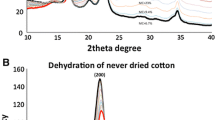Abstract
The relative reactivity of the I α and I β phases of Valonia cellulose toward partial homogeneous acetylation was investigated by FT-IR and CP/MAS 13C-NMR spectroscopy. At the beginning of the acetylation and when only partial reaction was achieved, it was found that the reactivity of the I α phase was substantially higher than that of the corresponding I β component. At a later stage of acetylation, the difference in reactivity between the two phases was less pronounced. In correlation with previous ultrastructural observations (Sassi and Chanzy, 1995), it can be concluded that at equivalent accessibility, the I α phase of cellulose is indeed more reactive toward acetylation than the I β phase. The homogeneous acetylation of cellulose is essentially a surface reaction that affects only the accessible parts located at the surface of the microfibrils. The decrease in the rate of I α phase disappearance with acetylation time confirms therefore that the microstructure of Valonia is made of domains that are distributed throughout the thickness of its microfibrils.
Similar content being viewed by others
References
Atalla, R. H. and VanderHart, D. L. (1984) Native cellulose: a composite of two distinct crystalline forms. Science 223, 283-285.
Belton, P. S., Tanner, S. F., Cartier, N. and Chanzy, H. (1989) High-resolution solid state 13C nuclear magnetic resonance spectroscopy of tunicin, an animal cellulose. Macromolecules 22, 1615-1617.
Debzi, E. M., Chanzy, H., Sugiyama, J., Tekely, P. and Excoffier, G. (1991) The I ? ? I ? transformation of highly crystalline cellulose by annealing in various mediums. Macromolecules 24, 6816-6822.
Finkenstadt, V. L. and Millane, R. P. (1998) Crystal structures of Valonia cellulose I ?. Macromolecules 31, 7776-7783.
Glegg, R. E., Ingerick, D., Parmerter, R. R., Salzer, J. S. T. and Warburton, R. S. (1968) Acetylation of cellulose I and II studied by limiting viscosity and X-ray diffraction. J. Polymer Sci., Part A2 6, 745-773.
Hayashi, N., Sugiyama, J., Okano, T. and Ishihara, M. (1998a) Selective degradation of the cellulose I?component in Cladophora cellulose with Trichoderma viride cellulase. Carbohydr. Res. 305, 109-116.
Hayashi, N., Sugiyama, J., Okano, T. and Ishihara, M. (1998b) The enzymatic susceptibility of cellulose microfibrils of the algal-bacterial type and the cotton-ramie type. Carbohydr. Res. 305, 261-269.
Heiner, A. P., Sugiyama, J. and Telleman, O. (1995) Crystalline cellulose I? and I? studied by molecular dynamics simulation. Carbohydr. Res. 273, 207-223.
Horii, F., Yamamoto, H., Kitamaru, R., Tanahashi, M. and Higuchi, T. (1987) Transformation of native cellulose crystals induced by saturated steam at high temperatures. Macromolecules 20, 2946-2949.
Horii, F., Hirai, A. and Kitamaru, R. (1987) CP/MAS 13C-NMR spectra of the crystalline components of native celluloses. Macromolecules, 20, 2117-2120.
Hurtubise, F. G. (1962) The analytical and structural aspects of the infrared spectroscopy of cellulose acetate. TAPPI 45, 460-465.
Imai, T. and Sugiyama, J. (1998) Nanodomains of I?and I? cellulose in algal microfibrils. Macromolecules 31, 6275-6279.
Kroon-Batenburg, L. M. J. and Kroon, J. (1997) The crystal and molecular structures of cellulose I and II. Glycoconjugates J. 14, 677-690.
Larsson, P. T., Westermark, U. and Iversen, T. (1995) Determination of the cellulose I?allomorph content in a tunicate cellulose by CP/MAS 13C-NMR spectroscopy. Carbohydr. Res. 278, 339-343.
Larsson, P. T., Wickholm, K. and Iversen, T. (1997) A CP/MAS 13C-NMR investigation of molecular ordering in celluloses. Carbohydr. Res. 302, 19-25.
Sassi, J-F. and Chanzy, H. (1995) Ultrastructural aspects of the acetylation of cellulose. Cellulose 2, 111-127.
Sisson, W. A. (1938) X-ray diffraction behavior of cellulose derivatives. Ind. Eng. Chem. 30, 530-537.
Sugiyama, J., Persson, J. and Chanzy, H. (1991a) Combined infrared and electron diffraction study of the polymorphism of native celluloses. Macromolecules 24, 2461-2466.
Sugiyama, J., Vuong, R. and Chanzy, H. (1991b) Electron diffraction study on the two crystalline phases occurring in native cellulose from an algal cell wall. Macromolecules 24, 4168-4175.
VanderHart, D. L. and Atalla, R. H. (1984) Studies of microstructure in native celluloses using solid-state 13C-NMR. Macromolecules 17, 1465-1472.
VanderHart, D. L. (1987) Natural-abundance 13C-13C spin exchange in rigid crystalline organic solids. J. Magn Reson. 72, 13-47.
Yamamoto, H. and Horii, F. (1993) CP/MAS 13C-NMR analysis of the crystal transformation induced for Valonia cellulose by annealing at high temperatures. Macromolecules 26, 1313-1317.
Author information
Authors and Affiliations
Rights and permissions
About this article
Cite this article
Sassi, JF., Tekely, P. & Chanzy, H. Relative susceptibility of the Iα and Iβ phases of cellulose towards acetylation. Cellulose 7, 119–132 (2000). https://doi.org/10.1023/A:1009224008802
Issue Date:
DOI: https://doi.org/10.1023/A:1009224008802




